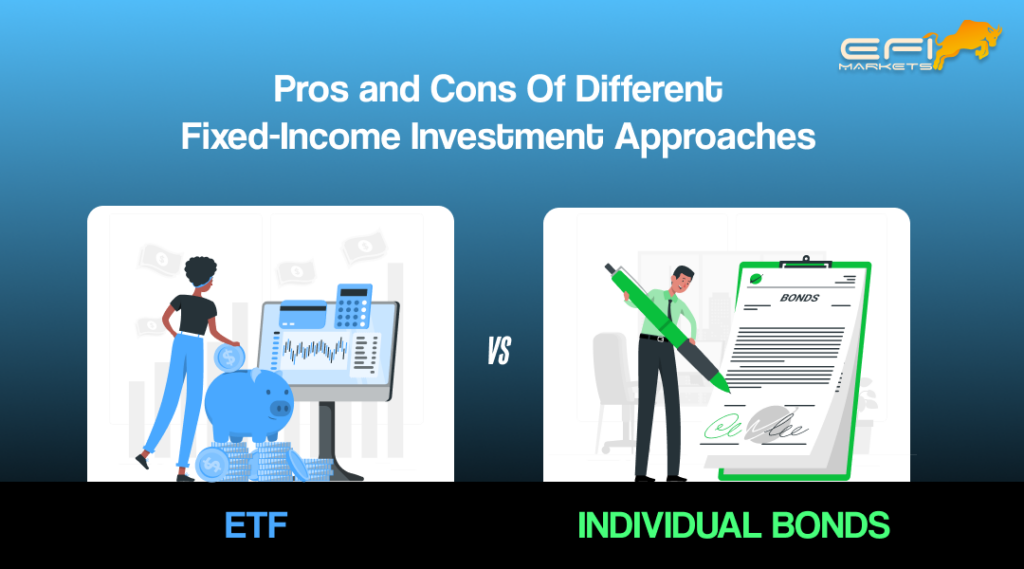
In the world of fixed-income investing, there are two primary approaches: investing in Exchange-Traded Funds (ETFs) or purchasing individual bonds. Both options offer distinct advantages and disadvantages, catering to different investor preferences, risk appetites, and financial goals. In this article, we’ll delve into the pros and cons of each approach to help you make informed decisions about your fixed-income investments.
Exchange-Traded Funds (ETFs)
Pros:
-
Diversification: ETF Trading provide instant diversification by holding a basket of bonds within a single fund. This diversification helps spread risk across various issuers, sectors, and maturities, reducing the impact of individual bond defaults.
-
Liquidity: ETFs trade on major exchanges throughout the day, offering investors the flexibility to buy and sell shares at market prices. This liquidity can be particularly advantageous during volatile market conditions when individual bond trading may be less liquid.
-
Accessibility: ETFs are accessible to investors of all sizes and levels of expertise. With low minimum investment requirements and ease of trading through brokerage accounts, ETFs make fixed-income investing more accessible and convenient.
-
Cost-Efficiency: ETFs typically have lower expense ratios compared to actively managed mutual funds. Additionally, investors can avoid transaction costs associated with purchasing individual bonds, making ETFs a cost-effective option for broad bond exposure.
Cons:
-
Management Fees: While ETFs generally have lower expense ratios than mutual funds, they still incur management fees that can erode returns over time, especially for actively managed ETFs.
-
Limited Control: Investing in ETFs means entrusting fund managers with portfolio decisions. Investors have limited control over the specific bonds held within the ETF and their respective characteristics, such as credit quality and duration.
Individual Bonds
Pros:
-
Customization: Purchasing individual bonds allows investors to tailor their fixed-income portfolios to meet specific investment objectives, risk tolerances, and income needs. Investors have the flexibility to select bonds based on factors such as credit quality, maturity, and yield.
-
Income Stability: Holding individual bonds to maturity provides a predictable stream of income in the form of regular coupon payments. This income stability can be particularly appealing for investors seeking consistent cash flow.
-
Control Over Holdings: Investors have full control over the selection and management of individual bonds in their portfolios. They can conduct thorough research on issuers, assess credit risk, and make informed decisions based on their own analysis.
Cons:
-
Lack of Diversification: Investing in individual bonds requires a larger capital outlay to achieve adequate diversification compared to ETFs. Without diversification, investors may face higher concentration risk, particularly if one bond defaults.
-
Illiquidity: Unlike ETFs, individual bonds may lack liquidity, especially for less commonly traded issuers or securities with longer maturities. Selling individual bonds before maturity may result in wider bid-ask spreads and potential price concessions.
-
Higher Transaction Costs: Building a diversified portfolio of individual bonds often entails higher transaction costs, including broker commissions and markups. These costs can eat into returns, particularly for smaller investors.
In conclusion, both ETFs and individual bonds offer unique advantages and drawbacks in the realm of fixed-income investing. ETFs provide diversified exposure, liquidity, and accessibility at a relatively low cost, making them suitable for many investors seeking broad bond market exposure. On the other hand, individual bonds offer customization, income stability, and control over holdings, appealing to investors with specific preferences and risk profiles.
Ultimately, the choice between ETFs and individual bonds depends on factors such as investment objectives, risk tolerance, time horizon, and the level of involvement desired in portfolio management. By carefully weighing the pros and cons of each approach, investors can construct fixed-income portfolios that align with their financial goals and preferences.
